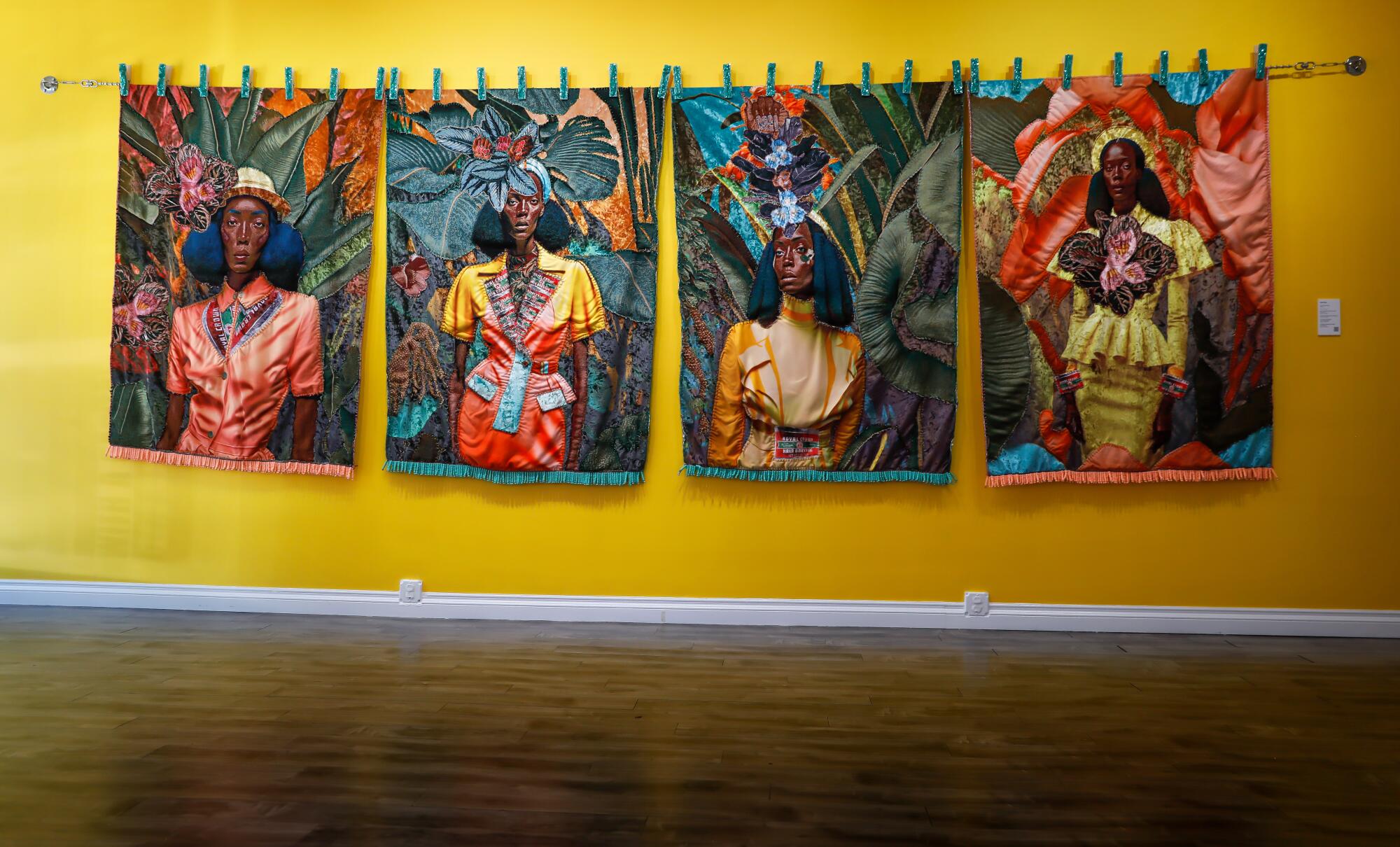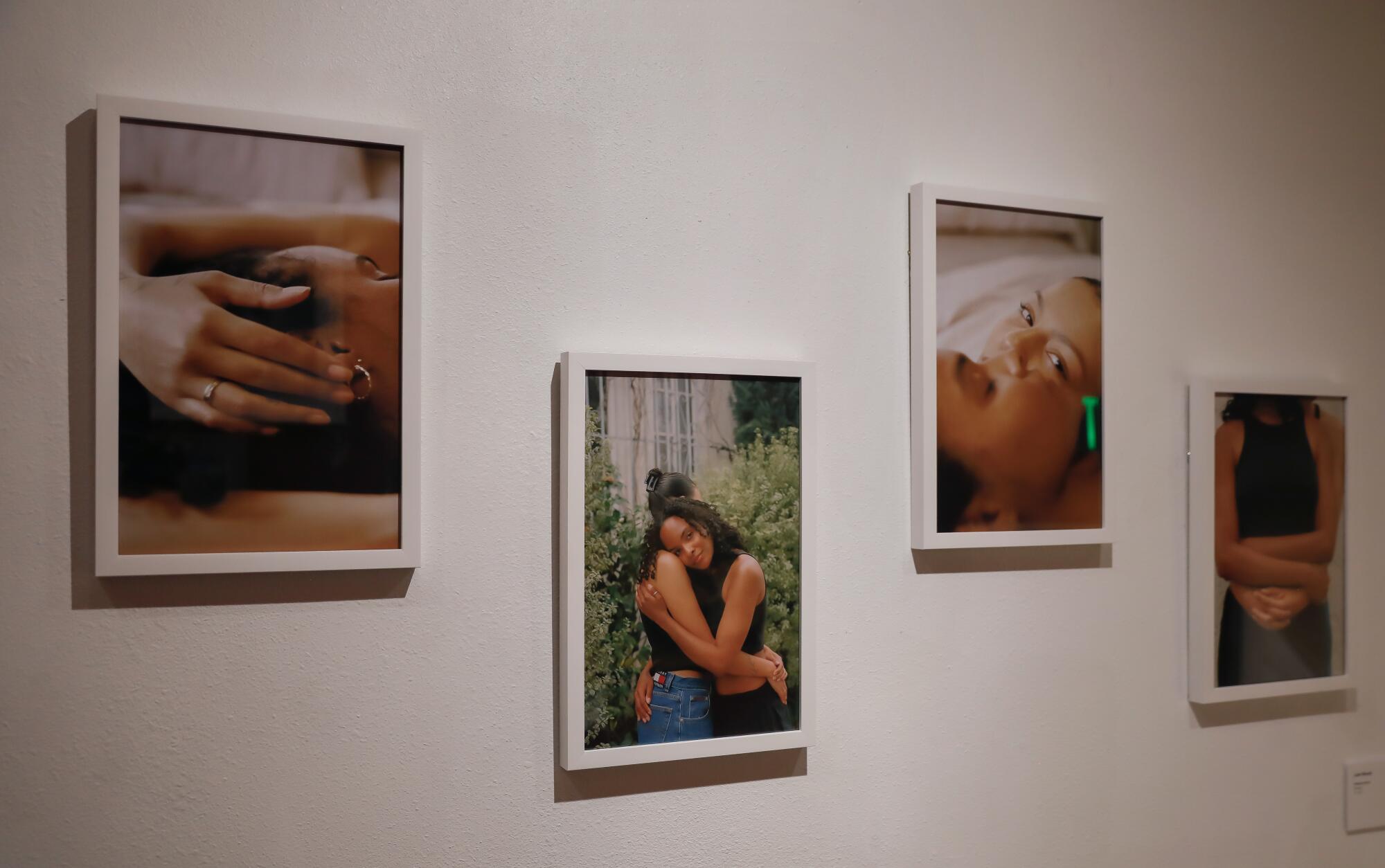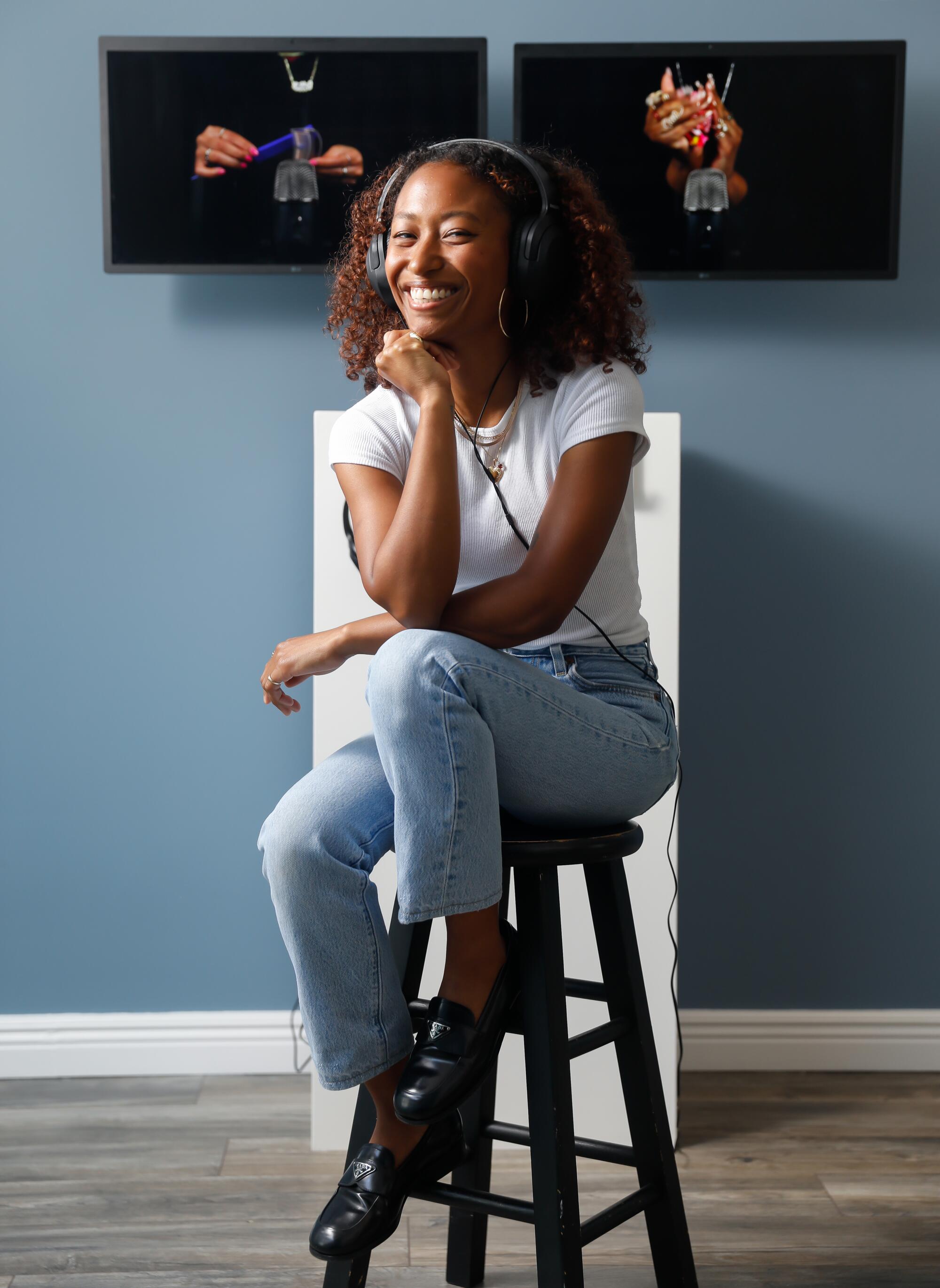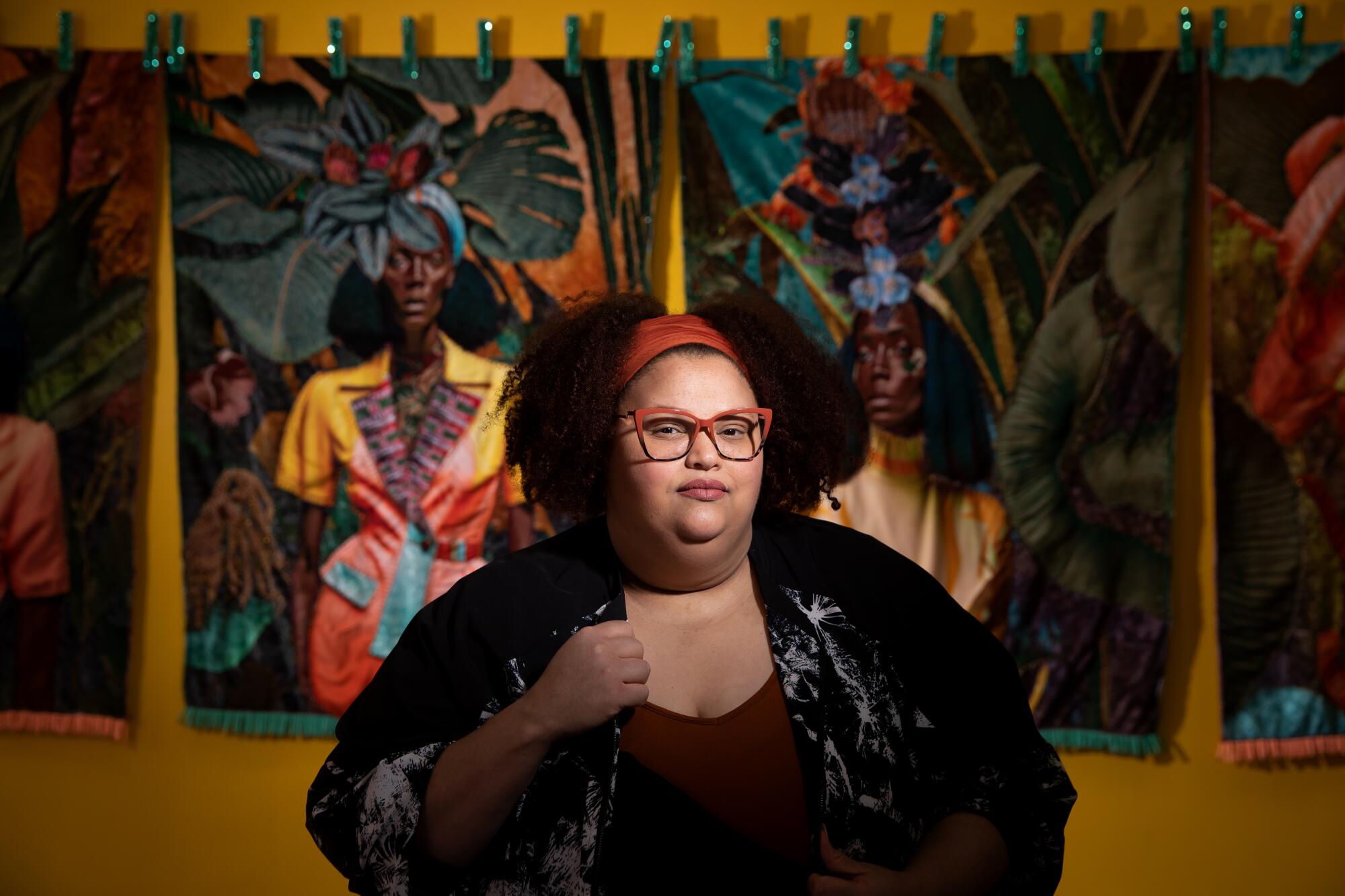
- Share via
Last month, WACO Theater Center in North Hollywood debuted “Witness,” a multimedia exhibition centering the perspectives of L.A.-based Black women and nonbinary artists. On view through May 27, the collection was curated by WACO’s co-founder Tina Knowles Lawson and Genel Ambrose, founder of the cultural programming incubator Good Mirrors. The 14 featured artists explore themes of family, community and identity in works that feel celebratory, honest and uninhibited.
“Black women are underrepresented,” said Knowles Lawson, an avid collector of African American art. “It just seems to be tougher for them to get started and to get their work out there. So, this was a labor of love, really.”

That uphill battle can be so daunting that one of the show’s artists had a hard time even imagining such an opportunity could be real. Filmmaker Amber J. Phillips, whose 2021 short film “Abundance” is on display in the exhibition, said she was in such disbelief when WACO’s director of communications and strategy, Nijeul X, reached out to her that she disregarded his introductory email and continued to make the pot of butter beans she had been preparing.
She wasn’t readily convinced the curators would be genuinely interested in providing a platform for her work, which unapologetically comments on white supremacy and its impact on her life as a self-identified “dark-skinned, fat Black girl from the Midwest.” Ultimately, she was glad her initial misgivings were unfounded.
“When you take a closer look at why ‘Witness’ was created — which is to not only center Black women and femmes, but to see the world how we see the world — it’s so surprising, because it’s past due,” Phillips said. “Everybody wants to know what we think about them … or they want to present us to the world the way they want us to be. So few people ask us what we think about ourselves. To have the audacity to give us a stage and a place to show that and invite other people in is just a dream.”

A 1971 quote from Toni Morrison was the curator group’s “North Star,” inspiring the show’s conceptual direction: “And she had nothing to fall back on: not maleness, not whiteness, not ladyhood, not anything. And out of the profound desolation of her reality she may very well have invented herself.”
“We were very keen on having a diverse range of artists who, in many ways, extend the tradition of Black feminist thought through their work,” Ambrose said. She continued, adding “all of the artists reflect on how they’ve invented themselves in a society that doesn’t often see and acknowledge the brilliance and beauty of Black women.”

The venue — which Knowles Lawson and her husband, Richard Lawson, opened in 2017 — typically hosts musical and theatrical productions, film screenings and educational programs. “Witness” is a unique visual art venture for the center, its works dispersed throughout the lobby, theater and hallways, as well as a next-door annex — formerly used for storage and office space — that has since been affectionately dubbed “WACO North.”
“I was blown away seeing our little theater look so much like a gallery — it was transformed,” said Knowles Lawson. “I got so emotional when I walked in and saw it all together. It really hit different because it was all women. There’s such strength, vulnerability and love.”
We spoke with several of the participating artists who attended the opening reception to discuss their eclectic yet spiritually linked entries in the exhibition.

Amber J. Phillips
According to Phillips, her short film “Abundance” is an exploration of what it would look like for women like her to be the center of their own universe. “When you’re ignored in society, when you aren’t included, when things literally aren’t made for your body to exist in certain places, in that slippage, in people not paying attention, what can be created? Who can we become?”
Standing a few feet away from the wall-mounted monitor showing the film, there’s a vintage vanity that Phillips refurbished by hand. She explained that the positioning was intentional: While watching “Abundance,” viewers are reflected in the looking glass, thereby inserted in the world she’s created. “This isn’t just about me,” she said. “I want you to see yourself in my story so you can take some responsibility for what comes next for all of us.”

Dana Davenport
Dana Davenport’s interdisciplinary work delves into her Korean and Black American heritage. For “Witness,” she focused on pieces that address the important role that Black women’s hair plays in both cultures.
Three pieces from her “Box Braid Chandelier” series are suspended from the ceiling in the annex’s entryway — steel structures wrapped with multicolored synthetic hair and adorned with plastic beads and handmade clay barrettes bearing Korean words. She described them as the result of a personal journey to discover “how the hair, sitting on the shelf inactive, is transformed in the hands of Black folks through love, through care and through labor.”
“I imagined these chandeliers as objects to look up at and be in awe of,” Davenport said, noting that she’s literally and figuratively “elevating this material that has a really complicated history.”

The artist was raised in South Korea and moved to the U.S. in 2011. The first time she visited an American beauty supply store that caters to Black women, she was surprised to discover that, as with many such establishments, the proprietor was a Korean immigrant. By that time, she’d also begun to observe the racial tensions that have historically kept the two communities at odds. As a result of that strife, it’s all too common for hair care shopping experiences to be plagued by distrust and, at times, hostility between customers and merchants.
Davenport offers a glimpse at her idyllic vision of what those shopping experiences could be with her reproduction of a retail aisle shelf — a portion of a larger 2021 installation called “Dana’s Beauty Supply” — which is meant to get visitors “thinking of ways in which we can reimagine [the stores] as a space for solidarity.”
“It is already a space for creativity and for beauty, but how do we also incorporate accountability? How do we have some of those different conversations around Black and Asian solidarity?”
In the two-channel video installation “Beauty Supply ASMR,” pairs of hands rub the edges of plastic hair rollers together and run sharpened nails down the teeth of combs to trigger a sensory response in the viewer.
“I am an [autonomous sensory meridian response] junkie,” Davenport explained. “So, it just felt natural to incorporate objects from the beauty supply store into a video that’s very soothing and allows people to experience the care that these products provide for the Black folks who use them.”

Liam Woods
On a brightly lit stairway off WACO’s main hallway, you’ll find four intimate snapshots by trans, nonbinary photographer Liam Woods. The images are part of their “Welcome Home” series, which centers queer joy. A sun-dappled hand softly caresses a reclining loved one’s temple in one photo, while in another, a couple’s arms are draped in a gentle embrace.
“They’re friends of mine and I wanted to show how they find solace in one another during hard times like this,” Woods said. “With the state of the world and what’s going on with all of the anti-LGBTQ bills that are going into effect, and the Uganda death penalty, it’s more important now than ever to spotlight images like this and be able to uplift those voices within the community.”
They explained that the core of their practice is providing representation for queer, nonbinary and trans people of color.
“I’m just really coming from a place of love, acceptance and celebration,” they said, expressing a desire to provide viewers with an opportunity “to get away from all of that darkness and see how we really stand in this beautiful light.”

Rebecca Henry and Akua Shabaka, House of Aama
Rebecca Henry and Akua Shabaka, the mother-daughter duo behind L.A.-based fashion label House of Aama, spent the better part of three days creating their assemblage installation, “Sanctuary: Tales of a Conjurer Woman,” along the entire back wall of WACO North. What they created was an altar filled with lit prayer candles and fresh flowers, and interspersed tables covered with lace doilies and topped with seashells, antique dolls, instruments fashioned out of gourds, books about voodoo rituals and framed photos of Harriet Tubman, boundary-breaking journalist Ida B. Wells and authors Octavia E. Butler and Zora Neale Hurston.
A quilt, handmade by Rebecca and marrying Black Southern folk art traditions with West African symbols and textiles, was draped behind it all. She described “Sanctuary” as “dealing with the Black feminine gaze — when we’re peering out into space, looking forward and looking backward, what it is that we’re seeing and imagining.”
“A lot of these things are coming from our own altars in our house,” Akua added. “When people see our work, I want them to understand that this is directly a reflection of us and our familial lineage and how we identify as Black women.”
Designs in their latest collection feature names like “Anansi,” the West African folklore character, and “Maroon,” the enslaved Africans who escaped and evaded their captors across the Caribbean. The pair, who’ve been designing clothing together since Akua was in high school, frequently erect similar altars at their fashion shows.
“We’re folklorists and anthropologists,” Henry said. “Our brand, our assemblage work is focused on the Black experience and unpacking nuanced histories. Always, as a part of that, we have the spiritual component where we’re calling on that divine ancestor that’s feminine.”

April Bey
The statuesque figures in April Bey’s woven tapestry polyptych, “Sankofa, They/Them,” don’t so much look at you as through you. Each has regal bearing, refined attire and a fierce, unbothered stare.
“The work is made from the premise of me being an alien from another planet, Atlantica,” Bey explained of her Afrofuturistic textile creations. “We’ve long-since celebrated this imagery on our planet. On Atlantica, we have no concept of race, so a lot of my work is commentary on how primitive Earth still is and how we watch it like a [TV] reality show, like, ‘Oh, it’s so cute — they still have genders!’”
She said the alien narrative is a therapeutic tool she uses to help her maintain sanity. As a child, she was told by her “Trekkie sci-fi blerd of a father” that they’d been “sent to Earth as operatives to observe and report. He made me feel like we were better than those scrutinizing our hair or positionality in life … and instead, placed us in an evolved narrative with a dash of adventure.”
A multidisciplinary artist and Glendale College professor who hails from the Bahamas, Bey infuses her extraterrestrial work with down-to-Earth imagery from the island nation. All around her fabric fashion brigade, there’s lush tropical foliage and flowers that, upon closer inspection, are revealed to be folded hands bearing long, brightly-colored fingernails. Black women’s acrylic nails, she explained, were always considered a hallmark of beauty in her Caribbean community. (“Where I’m from, that’s all we know!”) She also accessorized the figures’ outfits with images of the Royal Crown hair dressing label, worn as lapels, belts and bangles. “A lot of my work comes from trying to see the similarity of the diaspora,” she said, referencing the century-old product’s popularity among Black customers around the globe.
“In the exhibition, you have traditional modes of capturing and witnessing blended seamlessly with new media and installation. My tapestries function as [a] mode of capturing Black opulence, inviting the audience to witness [it] as a regular occurrence.”
'Witness'
Where: WACO Theater Center, 5144 Lankershim Blvd., Los Angeles
When: Fridays through Sundays from noon to 6 p.m. through May 27
Info: (818) 400-1151; wacotheatercenter.com
More to Read
The biggest entertainment stories
Get our big stories about Hollywood, film, television, music, arts, culture and more right in your inbox as soon as they publish.
You may occasionally receive promotional content from the Los Angeles Times.










